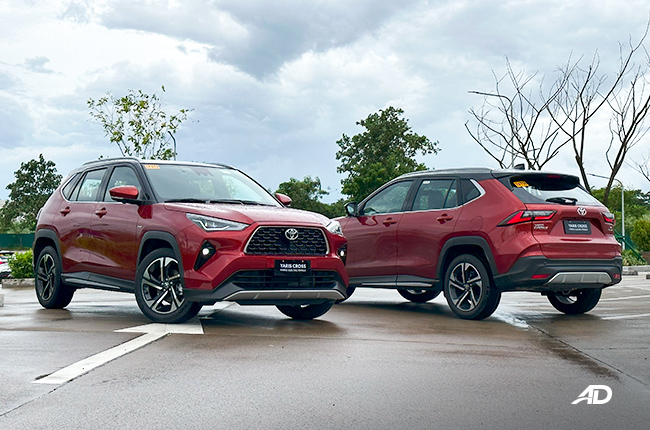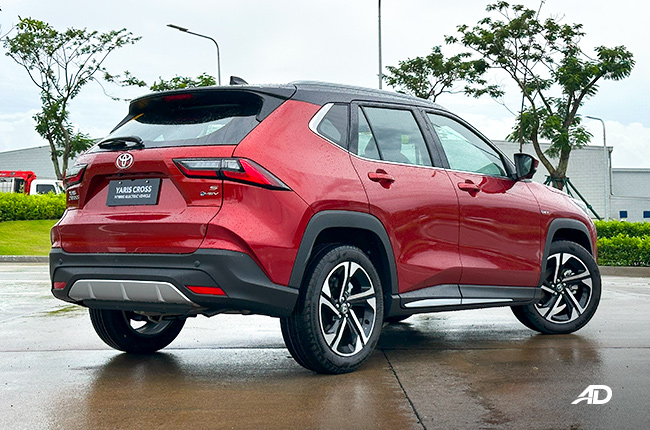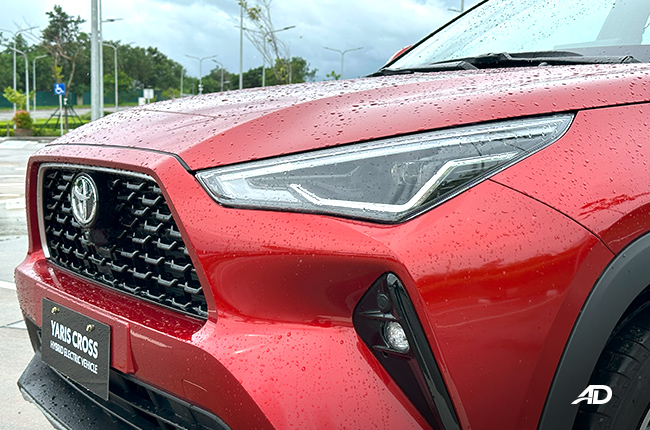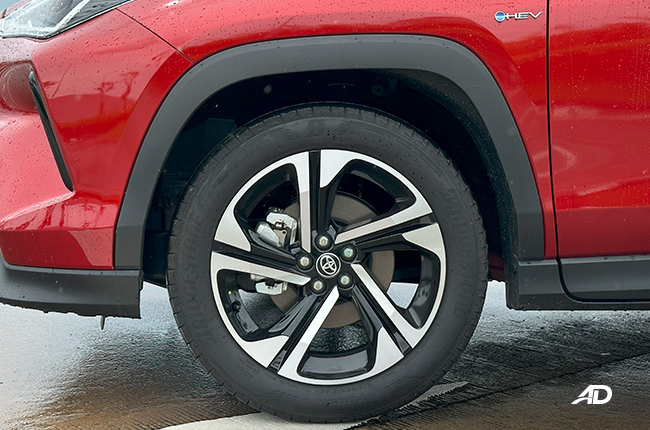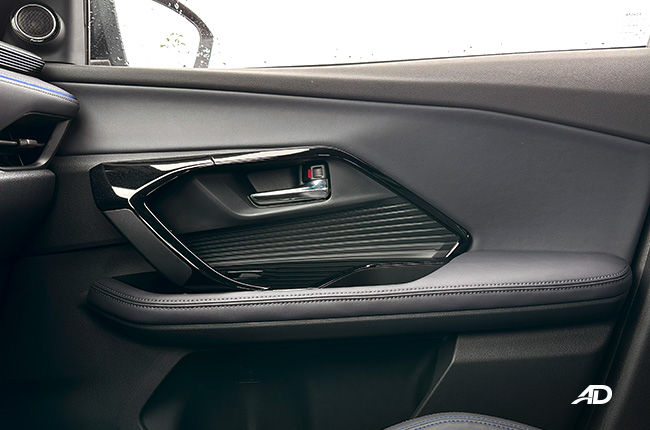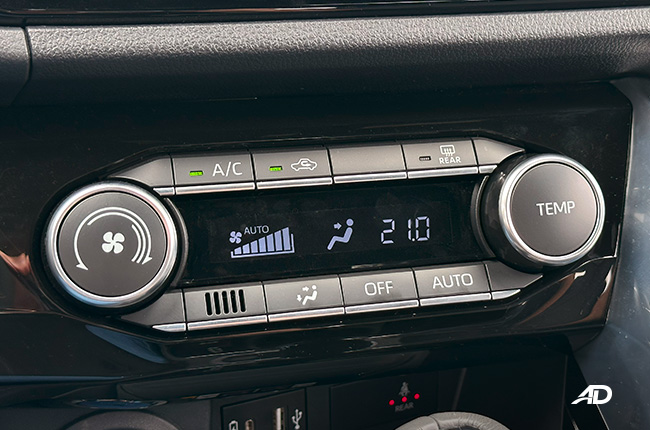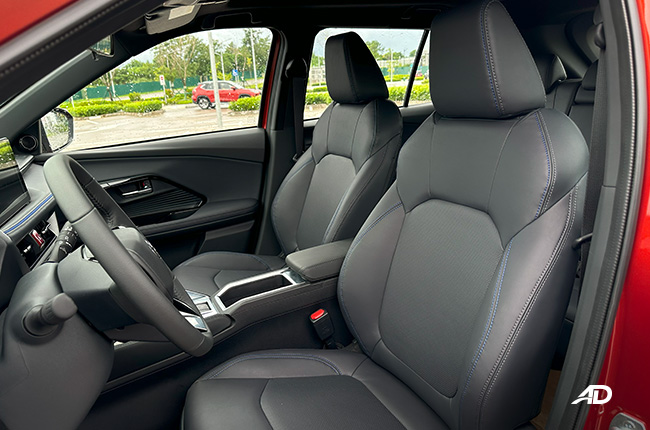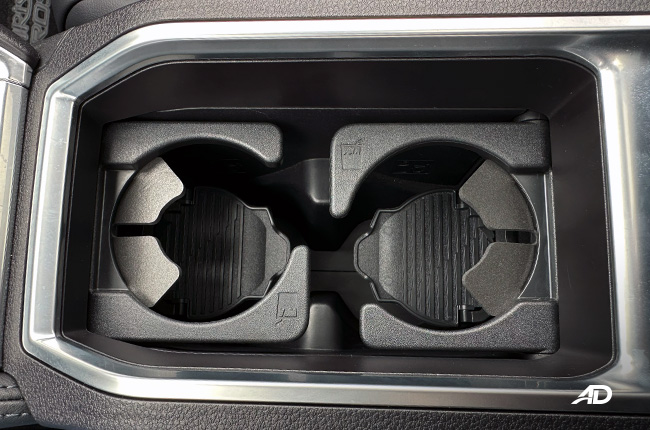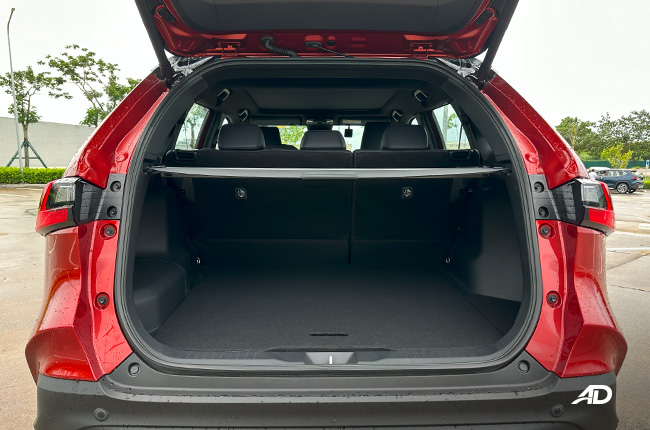
Toyota Motor Philippines is not looking to rest anytime soon with another addition to its ever-growing lineup in just a span of a few months—this time in the form of a small crossover, which is the Yaris Cross. Toyota’s aim for this model is to introduce hybrid technology to the masses at a more accessible price point.
The Toyota Yaris Cross HEV looks to combine style, efficiency, and comfort in a compelling package, making it an excellent choice for city dwellers seeking a fuel-efficient and modern hybrid crossover. We took it for a spin to see how this trendy vehicle fared on the road.
Exterior
The Toyota Yaris Cross HEV boasts sharp and edgy lines all around, giving it a sporty and hip exterior look. The blacked-out roof, sharp headlights, and bold grille contribute to its eye-catching appearance. The front and rear faux skid plates and matte black body cladding lend an air of ruggedness to the crossover's design.
The taillights draw inspiration from the popular RAV4 model, bringing cohesiveness to Toyota's lineup and reinforcing the brand's design language. In person, the Yaris Cross looks even better than in photos, with its well-proportioned body and attractive 18-inch diamond-cut wheels adding to the overall appeal.

However, some might lament the departure of the iconic blue Toyota badge that previously graced hybrid models. Instead, the Yaris Cross features a regular Toyota badge accompanied by HEV badges—now the only type of badge that refers to the hybrid powertrain. It remains to be seen if this trend will extend to other Toyota Hybrid models globally, but we do miss the blue Toyota badge since it gave the models a small but special touch.

Overall, the Yaris Cross’ design makes this crossover look larger than it actually is, which is a good thing since it enhances its road presence. Comparing it to the Corolla Cross, a design that many are already familiar with, the Yaris Cross has more striking lines and cuts on the car. Overall, it wouldn’t be so far-fetched to say that we preferred the design of this model over its bigger brother.
Interior

Step inside the Toyota Yaris Cross HEV, and you're greeted with a black leather interior adorned with stylish blue stitching that gives a hint of luxury. The dash features a striking blue accent line, adding a touch of elegance and sportiness to the cabin. It definitely doesn't look out of place as some of us initially assumed. The chunky and well-designed steering wheel provides a comfortable grip, enhancing the driving experience.
The interior's modern vibe is accentuated by piano black accents. However, it's worth noting that these areas can be fingerprint magnets, especially in high-touchpoint regions. Nevertheless, the overall interior quality is commendable, with sturdy materials and excellent touchpoints throughout.
Passengers in the rear enjoy a spacious and comfortable seating area. While there's nothing exceptionally groundbreaking about the rear space, it's practical and ample for a vehicle of this size. The split panoramic moonroof adds a touch of luxury, but its inability to open may leave some potential buyers longing for a fully functional one, which also negates why it’s a split design as well
A thoughtful addition is the configurable ambient lighting, which adds a touch of personalization to the cabin. The interior also features practical elements like the power lift tailgate, the inclusion of a tonneau cover, and an additional storage area under the floor for storing smaller items.
If there are areas to nitpick, it would most probably be that the shifter has a lot of play to it, and the faux-metal trimming surrounding the shifter and center console is a bit tacky looking and not up to par with quality. The central cupholders also feel a bit flimsy, giving us the impression that it could struggle to hold large American-sized drinks, but we do live in the Philippines, and you could also choose just to plop your drink down and opt not to activate the flimsy mechanism after all.
Technology and connectivity

The Yaris Cross HEV's technology and connectivity offerings are commendable. The centerpiece is the 10.1-inch infotainment display, which provides a clear view and is angled toward the driver for easy access. The inclusion of wireless Apple CarPlay and Android Auto ensures a seamless connection with compatible smartphones.

The Pioneer six-speaker audio system delivers good sound quality, though it may not leave audiophiles overly impressed. The infotainment display also houses 360-degree cameras and a panoramic view monitor, making parking and maneuvering a breeze.

The Yaris Cross also gets USB-C and USB-A ports in the front, along with two USB-C ports for rear passengers, offering ample charging options. This adoption of USB-C ports is a welcome addition, especially at this price point, future-proofing the vehicle's connectivity. Wireless charging comes as standard, and a thoughtful addition is an on and off button for the wireless charger, so you can have your phone plugged in and still keep it in the wireless charger slot. It also helps prevent your phone from overheating. It’s a small detail, but a very welcome feature.

Toyota leaves no room for compromise when it comes to safety. The Yaris Cross HEV comes equipped with Toyota Safety Sense (TSS), featuring Pre-Collision System, Automatic High Beam, Lane Tracing Assist, Lane Keeping Assist, and Adaptive Cruise Control. It's reassuring to see this comprehensive safety suite available even on entry-level models.
The driver gets a configurable digital gauge cluster where they can monitor the vehicle’s hybrid system along with TSS. Drivers can change the cluster design to suit their liking, and they can access various options for the Yaris Cross here. Though we wished it was a bit more intuitive.

You also get an eight-way power-adjustable seat, while the front passenger has to make do with a manual setup. Nonetheless, the seats are comfortable and supportive for both short commutes and longer journeys.
Performance and handling

Under the hood, the Yaris Cross HEV houses a 2NR-VEX 1.5-liter, four-cylinder engine, producing 89 hp and 121 Nm of torque. When combined with the hybrid system, the total output reaches 109 hp. Ideally, the powertrain should be making more power, but Toyota says that the output of the engine and electric motor will never be combined at its peak and instead prioritizes fuel efficiency over sheer power. The electric motor provides instant torque, making acceleration feel brisk, especially at lower speeds.

The Yaris Cross performs admirably as a city slicker and also easily reaches and maintains speeds, making it an efficient cruiser on highways. The addition of drive modes, including Sport and Eco, lets drivers tailor the driving experience to their preferences. However, some might find the engine's roughness during transitions slightly disappointing compared to smoother hybrids in Toyota's lineup, such as the Corolla Cross, Zenix, and RAV4.

On the road, the Yaris Cross handles well, responding to cornering with ease. While it may not be as athletic or engaging as the Nissan Kicks, it compensates with its charming design, fuel efficiency, and user-friendly nature.
Verdict
The Toyota Yaris Cross HEV impresses with its modern interior, bold exterior, and tech-savvy features. Its fuel-efficient hybrid powertrain ensures guilt-free city driving, while the comfortable and spacious cabin enhances the overall driving experience. With Toyota's proven hybrid technology and a relatively attractive price point of P1,598,000 for this type of electrified technology, the Yaris Cross HEV is a compelling option for those seeking a stylish and eco-friendly urban crossover.

It seems we might have another winner at our hands if the sales figures of the bigger Toyota Hybrid models are anything to go by. Competition is stiff, but the fact that there is a new hybrid on the block with a Toyota badge (that’s not blue, we’re still a little upset about that) and a lower price tag is a huge deal. We could very well be looking at the new best-selling hybrid in the market.
Latest Review
-
Addictively excessive: The Ford Ranger Raptor Twin Turbo V6 / Review
The Ford Ranger Raptor Twin Turbo V6 is one crazy pickup truck. Wondering why? Just keep reading.
4.6 / 5 -
The Kia Carnival gives you more: More seats, more comfort, and more practicality / Review
The Kia Carnival is a three-row MPV designed for executives and families. It combines comfort, technology, and practicality, making it a strong choice for those looking for a premium people...
4.2 / 5 -
The Jetour Ice Cream: A pint-sized EV that’s hard to ignore / Review
The Jetour Ice Cream is an adorable, pint-sized electric car that’s made for the city. Affordable and stylish, it’s easy to love, but does it tick all the boxes for you?
3.7 / 5
Popular Articles
-
Cheapest cars under P700,000 in the Philippines
Jerome Tresvalles · Sep 02, 2024
-
First car or next car, the Ford EcoSport is a tough package to beat
Jun 18, 2021
-
Car Maintenance checklist and guide – here’s everything you need to know
Earl Lee · Jan 12, 2021
-
Most fuel efficient family cars in the Philippines
Bryan Aaron Rivera · Nov 27, 2020
-
2021 Geely Okavango — Everything you need to know
Joey Deriquito · Nov 19, 2020
-
Family cars in the Philippines with the biggest trunks
Sep 20, 2023
-
Head to head: Toyota Rush vs. Suzuki XL7
Joey Deriquito · Oct 28, 2020
-
Why oil changes are important for your car
Earl Lee · Nov 10, 2020
-
2021 Kia Stonic — What you need to know about it
Joey Deriquito · Oct 16, 2020
-
Top 7 tips for buying a used car in the Philippines
Joey Deriquito · Nov 26, 2020

